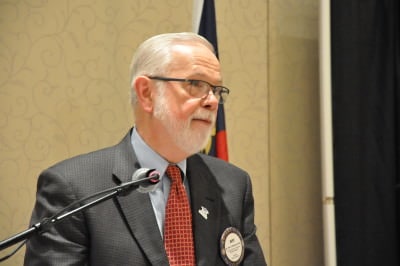

On a visit to Eastern Elementary School in Greenville last week, members of the State Board of Education were reminded of their ultimate goal — engaged students learning from excellent teachers.
They visited classrooms where students learned geometry through songs and pitched business plans to their visitors, who they thought looked like judges from the show “Shark Tank.”
Some of the students in Jami Dickerson’s class bounced on orange balance balls as a video they starred in brought many of the visiting state education leaders to tears. In it, each student held signs they wrote about their feelings coming into class:
“I felt like I wasn’t smart.”
“I thought I was too big.”
Then they flipped the sign to show how they felt now:
“I got straight As.”
“I feel like how I look doesn’t matter.”
But the school also highlighted some of the work to be done. For one, Principal Cathy Kirkland said four of the growing school’s 20 first-year teachers had already said they will not return in the fall.
“We just can’t keep them,” Kirkland told board members.
SBE in Greenville
Back at their three-day meeting at East Carolina University, the board discussed a host of issues that will affect the state’s schools in the long and short term, including the state’s changing student body and the need to fill classrooms with quality teachers.
The board also considered a few issues that will be decided in the shorter term, including the addition of more charter schools and changes to the state’s system for testing students and identifying students with learning disabilities.
Teacher Pipeline
Perhaps the most jarring information presented to the state board of education came from Alisa Chapman, the UNC System administrator who reported on an expected drop in the number of teachers entering the public schools from the state’s university system in the coming years.
The key fact:
Enrollment at the state’s 15 education programs dropped 27.6 percent between 2010 and 2014.
“Two years from now, or even a year from now, our public schools are going to begin feeling the effect of that enrollment decline,” Chapman said.
Chapman noted that the schools will likely have to turn to other sources of teachers, such as recruiting from out of state or increasing the number of teachers who come to teaching from other careers. But she also laid out data showing that, as a whole, teachers who enter the system from other states or after a career transition tend to be less effective in the classroom.
One notable exception was the Teach for America program, which places high-performing recent graduates into struggling schools. Those teachers outperformed state-trained teachers in many measures, but only 10 percent of them remained in their positions for at least five years, compared to 75 percent of teachers who enter the schools from state universities.
Chapman said the university system is retooling its recruitment efforts, though she noted this effort will be more difficult than in previous years now that state lawmakers have eliminated the N.C. Teaching Fellow program and salary supplements for teachers who earn master’s degrees.
“We don’t have all of the recruitment tools that we used to have,” said Chapman, Vice President for Academic and University programs.
Demographics


Another issue facing the public schools in the long term is the changing makeup of both its student body and the taxpayers who fund them.
UNC-Chapel Hill demographer James H. Johnson described to the board a series of demographic shifts that will challenge education leaders, including growth in the number of counties that have both high concentrations of retirees, who tend to resist funding schools, and low-income students in need of resources.
Segregation by race and income and an influx of immigrant students will also present further challenges and opportunities. Johnson said, “We are in the midst of (an) unprecedented series of demographic transformations.” The board and state education staff discussed the trends and possible solutions in small groups. “We ignore them at our own peril.”
Charter Schools
In a more immediate move, the board heard about 18 new charter schools that are recommended for approval in June, continuing the expansion of the publicly funded schools that critics claim have led to greater segregation of students and stripped traditional public schools of much-needed resources.
The majority of the schools were approved unanimously by the N.C. Charter School Advisory Board. Joel Medley, director of charter schools for the N.C. Department of Public Instruction, highlighted several schools that sparked controversy among the board members, who reviewed 40 applications for charter schools that would open in 2016.
Two were controversial mainly for their placement in the Raleigh and Charlotte areas, where charter schools are becoming more concentrated. Five of the recommended schools would open in Raleigh, including Capital City Charter High School, whose application would get an extra vote in January. Four would be in Mecklenburg.
Several schools were narrowly recommended after some advisory board members questioned their relationship with a management company that oversaw several Florida schools shuttered shortly after opening. Both Cape Fear Preparatory Academy in New Hanover County (6-4) and Town Center Charter High School in Gaston County (6-5) were approved.
If the board approves all of the new schools, the number of charters in the state would top 180, with more than 20 each in Wake and Mecklenburg. The board had little to say about the recommendations, which they’ll vote on next month.
Testing


The board saw an outline of a new testing regime meant to lessen the testing burden on students. The new system would call for staggered tests throughout the year, some of which are optional for local districts. This approach would lead to shorter end-of-grade tests for students, and allow schools to respond earlier when students do poorly on interim tests.
A pilot study on the system would be slated for the 2015-2016 school year if approved by the board; the new testing schedule would still be at least five years out. Among the questions for the board is whether schools that participate in the pilot will be exempt from the current end-of-grade tests.
Special education
The board also heard about plans to overhaul the way in which students with disabilities are identified, a change that it will vote on at its June meeting. Rather than comparing students’ scores on intelligence tests to their performance in school to see if they are achieving as well as would be expected, the new model would allow classroom teachers to try a series of evidence-based practices as soon as students encounter problems.
The new system is meant to identify students with disabilities earlier and more accurately.
“We used to have an alarm on the door,” said Nellie Aspel, director of exceptional children in Cleveland County schools, which has adopted the approach the state is considering. “Now it’s like having a fence around the house with bells on it.”
But some board members questioned whether the change would add to the teacher workload and possibly lead more children to be eligible for expensive special education services.
“I worry that even if our intentions are good and the research is right, the resources that are needed are just not available,” said board member Eric Davis.




